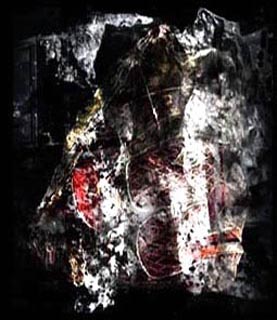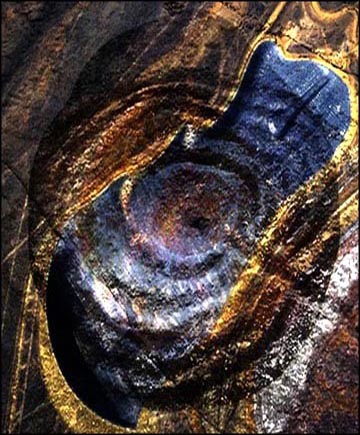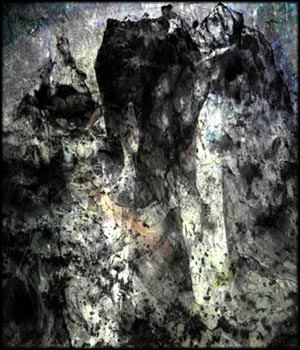From subterranean
depths, reinforced concrete stanchions rise to support a skyscraper's
layered world. We continue to build on modernism's flawed foundation,
posting old visions and ancient rites. Today's mythology is what
wasn't in yesterday's news; rather it "represents a state
of being and of culture almost completely at odds with the ordinary
and the mundane,"(5) making
for a picture of cleared ground dotted with small "cathedral
mounds," where the "aborigines humanize
their landscape, that is take possession of it conceptually,
through symbols."(6)
On Buddha's birthday there was
a circumambulation of Mt. Tamalpais, just north of San Francisco.
Walking uphill clockwise, we stopped at stone mounds along the
way to chant a short sutra and dharani, then
each of us would add another stone, "invocations of the
spirit of the place."(7) The
sense of sanctity continued, until descending the mountain
at the end of the day, we stood "in our little circle,
blowing the conch, shaking the staff rings, right in the parking
lot."(8)
From a scholastic viewpoint
the lineage of buddhas before the historical Buddha is mythological.
Even some of the dates of masters who lived after
Gautama Sakyamuni are skewed, in order to create a consistent
hagiography.
When a contemporary Zen Master was asked about this, he replied, "Of
course much of it is a myth." Then added, "But it's
true."
The psychic
moat between the sacred and profane is also the fence that
separates the city from wilderness. Liminality, the state of "ambiguity
and paradox, a confusion of all the customary categories,"(9) is
where instantiated
into some kind of platform, these components can be structured
so to build up increasingly
levels of complexity,
eventually arriving at complexity so deep, multilayed, and extensive
as to simulate the most complex phenomena on earth, from turbulent
flow and malignant social systems to reasoning processes the
initiate learns that
moats silt over and fences rot.
"We shall not reply by
indicating a means of access, for example, through a given
form of architecture: preamble, pronaos, threshold,
methodical route, circle or circulation, labyrinth, flight
of stairs, ascent, archaeological regression toward a foundation,
and so on."(10)
With ways to approach, but no
access, we reach a point of knowledge, of gnosis,
where the place of initiation, the threshold, is everywhere.
Consciousness can't be transformed without its host's environment
in mind: there is no separation between who we are and where
we are.
In one of two
magisterial books on the philosophy of place, Edward Casey wrote:
"To be is to be in place."(11) Like
other Western philosophers, Casey was trained in
a tradition that extends back to Ancient
Greece; in particular, to Aristotle. I'd like to suggest that
place is an "ecotone," an interface that doesn't
exist
without other places. Thus, to be is not to be in place,
but between other places.
The
liminal is the "borderland" where we are more
and less than ourselves.
"Borderland
people personally experience, and must live out, the
split from nature on which the western ego, as we know
it, has been built. They feel (not
feel about) the extinction of species;
they feel (not feel about) the plight
of animals that are no longer permitted to live by their
own instincts, and which survive only in domesticated
states to be used as pets or food."(12)
|
 |
"And
if I am not in a psychic field with others—
with people, buildings, animals, trees—
I am not."(13)
If we read "psychic field" as awareness
that includes the somatic and sensual, our very existence
depends on psychic integration with where we are and all
it contains. We are not placed. We are place itself.
|
i am on
the deck of a barge that holds large steel containers. i tap
each one with a cane, listening to the
signature of its ring. Finally, one sounds unique. i lift its
lid. Inside a seemingly dead woman begins to color. She rises
slowly,
then flies toward me! i panic and run.
In
the lobby of the Brooklyn apartment house where i was raised,
there are three boys staring
through
its glass doors. The
older one is saying that we mustn't run from her, but "Welcome
and embrace her."(14)
Transformation
is appealing, but its practice may be the ultimate
challenge to humanity. One's illusions, inherited or self-built,
tumble down; their remains, like autumn leaves—such
colors!—are swept up and left
to molder.
"The broom or brush sign (on the vulture's
wings at Çatal
Hüyük) denotes
the energy and power of the Death Goddess, as does the witch's
broom of European folklore."(15)
The "witch" was being purged of the
Devil, while her broom flew away!
Putting aside
statistical probabilities and lines of ascent, imagine a place
"conceived as both primordial space and the primordial
time of the event,"
which "would
allow a genuine alternative to modernity—or,
at least, to modernity traditionally understood—by
giving place precedence over both modern space and time."
However, "to 'synthesize' pre-modern and
post-modern ideas of place would
be to imply that place is (as
essence of places) and
that it is not (as
event-like
non-essence of places)—a flat contradiction."(16)
Only the dead
can sink into the reality of a place. For the living,
place is always slippery underfoot.
After
the leaves have fallen, we return
To a plain sense of things. It is as if
We had come to an end of the imagination,
Inanimate in an inert savior.(17)
In the hills and
along the streets communities of trees open their arms to crows,
starlings, robins, jays, and others flying species who unfailingly
navigate
a trackless
sky, along with ants and squirrels and an occasional cat who
run up and down their trunks. Even though
there
may be pictures of it, or travelogues written about it, a place
is only potentially extant, like subatomic particles, super-positioned
in space.
Each culture
has its own cartography. Place may
be "up the road a piece," "yonder," "five
point three miles,"
"due south
of
the
next
oasis." Ask an Australian Aborigine where a place
is and "you will
be given directions from some other place, not from where you
are. This
reference place will not be mentioned
in the original question but will be somewhere significant and
assumed to be well known."(18)
In
the spring of 1689, the renowned poet Matsuo Bashō stopped
to ask directions from a man cutting grass in a field. "Courteous,
he thought awhile, then said, 'Too many intersecting roads.
It's easy to get lost. Best to take that old horse as far as
he'll go. He knows the road. When he stops, get off, and he'll
come back home.'"(19)
Modern
societies have no initiatory process into the Mysteries,
such as Eleusis and Delphi. Theologians and anthropologists
may offer some newly excavated facts, but as religious
myth is buried in dogma, creative liminality
must be sought in
the "collective unconscious;" specifically in
what C.G. Jung calls "big dreams," where we are "transitional
beings" who have "no status, property, insignia,
secular clothing, rank, kinship position, nothing to demarcate
them structurally from their fellows."(20)
One
loses one's self, at least temporarily, where language
is not a tool for communication that belongs to us.
Language is not an exclusively human ability at all. It
is a field
of meanings and intentions that we inhabit. Human language
grows out of the world itself. We speak because soma
and society are delicately balanced. Here the moral
haunt of a culture can be seen in the visionary breadth
of
its reconstruction.
|
 |
Construction site—
Yellow machines abandoned
To the rain.
Analyzing menhirs
from the Neolithic and Bronze ages in Brittany, Christopher Tilley
wrote: "They
took on their meanings in relation to the experiences and feelings
of those people
who lived with them in the landscape through particular modes of
encounter and engagement."(21)
Of course it also works the other way around:
People derive meaning from their experiences and feelings of
a place
and its contents.
In
all cases, there is a complex web of connections
between the sensory experience of a place, the meaning of the
place and
the symbols that express and enhance both the sensory
experience and the meaning.(22)
The
third and final stage of the liminal process is when the initiate
is reassimilated into the community, the equivalent of the
famous Zen
Way: First there is the mountain; then there is no mountain;
then there
is the mountain again. However, as with the community, the
mountain is experienced differently. "The
world is our consciousness, and
it surrounds us."(23) Although
this view is too anthropocentric, it hints at the need
for psychic integration with one's environment.
At the beginning
of his last long trek through 17th Century Japan, Matsuo Bashō wrote, "every
day is a journey, and the journey itself is home." For Bashō,
inspiration for his poems was found in places
where ancient poets, warriors and priests who had become cultural
icons had visited. The ancestors of Australian Aborigines were
gods who had stopped their journey long enough to become recognizable
terrestrial forms that were reimagined by each generation during
a "walkabout." Every society has at least the memory
of an initiatory sojourn, which modernity has all but demeaned
into "spiritual tourism." In Western culture, the
arcane knowledge or ‘gnosis’ obtained in the liminal
period is felt in the change in the inmost nature of the neophyte,
impressing him, as a seal impresses wax, with the characteristics
of his new state. It is not a mere acquisition of knowledge,
but a change in "the idea of objective space
involves the idea of a multiplicity of positions or locations
within it."(24) With
this in mind, the neighborhood is the threshold,
and the journey itself.
| |
To the north was the
sea, the waves rolling in at a place called Tide Crossing.(25)
To the north,
an industrial section verges
along a river that joins another flowing
one hundred miles to the sea.
|
|
To the west, Muyamuya
Barrier
cut off the road.(25)
To
the west,
the forest I walk photograph and write populates
hills with thousands of tall green
umbrellas.
|
 |
Eastward lay an embankment,
with a road leading offf to Akita.(25)
Looking
east, a freeway held
high by concrete pillars is
a source of air pollution, cultural separation and
aesthetic regret. |
| |
To the south, Chokai
upheld the heavens, its reflection in the waters.(25)
To
the south runs a
heavily-trafficed street that divides two neighborhoods
like a river
too swift cross: the lights change too fast!
|
|
1- Miller, J. and Hilbert,
V. (1996) "Lushootseed
Animal People: Mediating and Transformation from Myth to History." In,
J. Arnold, Editor, Monsters, Tricksters and Sacred Cows.
Charlottesville: University Press of Virginia.
2- Wallace, J. (2004) Digging the Dirt: The Archaeological Imagination.
London: Duckworth.
mainstream climate scientists: E. Kolbert, “Butterfly Lessons.” The
New Yorker, Jan 9, 2006.
3- Dahl, D. (1985 ) The Other Room. Santa Barbara: Tsunami Press.
4- Weishaus, J. "Clearing the Ground." In, Feels
Like Home Again: Collected Poems 1962-2002. http://www.cddc.vt.edu/host/weishaus/cont-p.htm
5- Turner, V (1992) Blazing the Trail. Tucson: University of Arizona
Press.
6- Rapoport, A. (1977) "Australian Aborigines and the Definition of Place." In,
P. Oliver, Editor, Shelter, Sign & Symbol. Woodstock: The Overlook
Press.
7- Gennep, A.V. (1960) The Rites of Passage. Chicago: University of
Chicago Press.
8- Snyder, G. (1996) "The Circumambulation of Mt. Tamalpais." In, Mountains
and Rivers Without End. Washington, D.C.: Counterpoint.
9- Turner, V. (1987) “Betwixt and Between: The Liminal Period in Rites
of Passage." In, L.C. Mahdi, et. al., Editors, Betwixt & Between:
Patterns of Masculine and Feminine Initiation. LaSalle: Open Court.
instantiated into some kind of platform:
N.K.Hayles, My Mother Was a Computer. Chicago: University of
Chicage Press, 2005.
10- Derrida, J. (2008) "No (Point of) Madness—Maintaining Architecture." In, Psyche:
Inventions of the Other. Volume 2. Stanford: Stanford University Press.
11- Casey, C.S. (1993) Getting Back Into Place.
Bloomington: Indiana University Press.
12- Bernstein, J. (2005) Living in the Borderland. London: Routledge.
13- Hillman, J. (1992) We've
Had a Hundred Years of Psychotherapy and the World
is
Getting Worse. (with M. Ventura) New York: HarperCollins.
14- Weishaus, J. "Dream." "Reality Dreams-Scroll Eleven": http://www.cddc.vt.edu/host/weishaus/Real/real-11.htm
15- Gimbutas, M. (1989) The Language of the Goddess. San Francisco:
Harper & Row.
16- Brockelman, T. (2003) “Lost in Place? On the Virtues and Vices
of Edward Casey’s Anti-Modernism.” Humanitas,
Vol. XVI, No. 1.
17- Stevens, W. From, "The Plain Sense of Things."
18- Lewis, D. (1976) "Observation on Route Finding and Spatial
Orientation Among the Aboriginal Peoples of the Western Desert Region
of Central
Australia." Oceania (June)
19- Bashō, M. (1991) Narrow Road to the Interior. S. Hamill,
Translator. Boston: Shambhala.
20-
Turner, V. (1987) Ibid.
language is not a tool: T. Cheetham, Green Man, Earth Angel. Albany:
State University of New York Press, 2005.
21- Tilley, C. (2004) The Materiality of Stone: Explorations in
Landscape Phenomenology. Oxford: Berg.
22- Chazan, M. and Horwitz, L.K. (2009) “Milestones in the Development
of Symbolic Behaviour: a Case Study From Wonderwerk Cave, South Africa.” World
Archaeology Vol. 41(4).
23- Snyder, G. (2010) Etiquette of Freedom: Gary Snyder, Jim Harrison
and The Practice of the Wild. Berkeley: Counterpoint.
24- Malpas, J.E. (1999) Place and Experience. Cambridge: Cambridge
University Press.
the arcane knowledge or 'gnosis: V. Turner, Ibid., 1987.
25-
Bashō, M. (2005) "The
Narrow Road to the Deep North." In,
D.L. Barnhill, Translator, Bashō's Journey. Albany:
State University of New York Press.